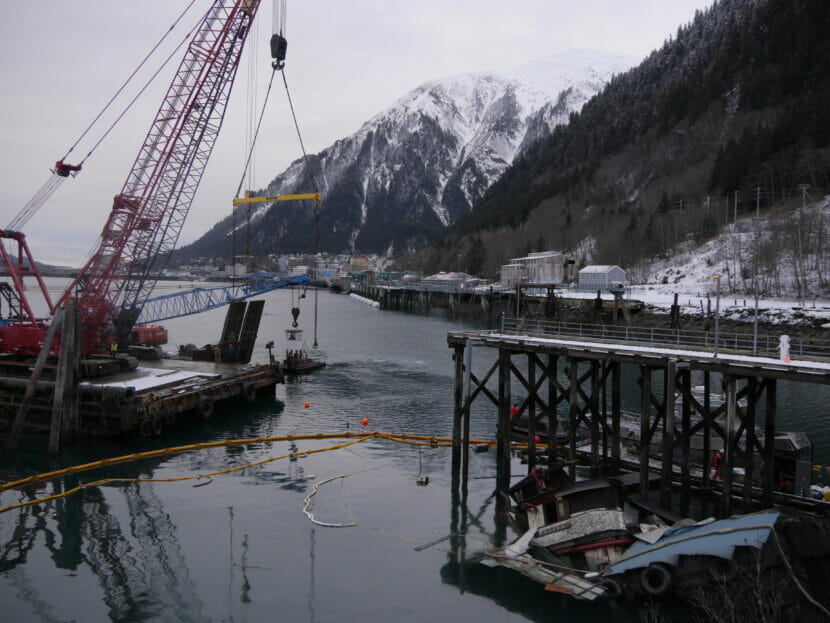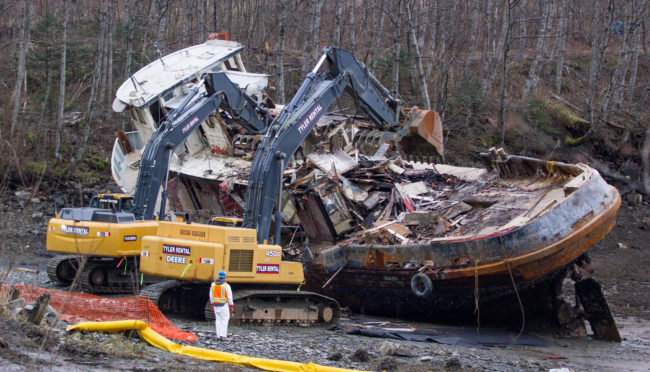
The Tagish, a 107-foot World War II tugboat, has finally been hauled away after nearly two months underwater.
The uninsured, 81-year-old wooden boat sank just south of Juneau’s cruise ship docks in December last year, following a cold snap that may have cracked its pipes. Its sinking ends a decades-long restoration effort by Juneau local Don Etheridge.
When the Tagish sank with approximately 60 gallons of diesel fuel and 50 gallons of lube oil on board, the U.S. Coast Guard was called in to address the pollution threat.
“The vessel was really contaminated,” said Chief Mike Ryan with the Coast Guard’s Incident Management Division. “It was a very old vessel with a lot of different fuel tanks.”
The cleanup, which wrapped up late last week, took more than two weeks and cost at least $650,000 — a cost that Ethridge, who did not have insurance for the vessel, could not cover up front.
When vessel owners don’t have the means to clean up pollution, the Coast Guard may be called in to take over. Often, that happens when a boat finally sinks.
“We deal with this maybe three or four times a year here in Southeast Alaska. So it’s not something that happens like every week,” Ryan said. “But I’d say in the long run, there’s probably going to be more issues with aging vessels. I think that’s just the nature of having a boating community.”
It’s hard to restore old vessels to their former glory, as Etheridge attempted. At the time of the sinking, he had replaced the interior and half the deck, which cost thousands of dollars.
“It scares me to think about how much I put into it,” Etheridge said.
But in some cases it’s even harder, and more expensive, to get rid of them.
“It costs you a small fortune to get rid of a boat,” said Etheridge, who is also chair of the Juneau Docks and Harbors board. “It’s cheaper to just keep paying your mortgage than it is to get rid of the boat.”
For many years, Etheridge even had the boat insured.
“And then the insurance company notified me that they weren’t going to insure it no more,” he said. “They canceled my insurance. Because of the age of the boat, being as old as it is.”
And just like that, Etheridge’s hobby project also became a huge liability. In Alaska and many other coastal states, the aging of the fleet presents a costly environmental hazard. According to a study from the Alaska-based McKinley Research Group, 54% of vessels in Southeast Alaska were built before 1980, which is beyond the typical lifespan for most boats.
But owners of older vessels are often left with few options.
“The Tagish is a symptom of a bigger problem,” said Juneau Harbormaster Matthew Creswell. “There is not an easy, cost-effective way to dispose of vessels when they reach the end of their useful life.”
Old tug boats, specifically, have caused multiple headaches in Juneau in the last decade. First, there was The Challenger, a 71-year-old wooden tug that sank near the Mendenhall Wetlands State Game Refuge back in 2016. It took six weeks and nearly $2 million to recover.

Then the Lumberman, which was scuttled and sunk in 2021, after it was abandoned in city and state-owned tidelands for years. Its disposal cost Juneau Docks and Harbors $160,000, with an additional $70,000 from the federal government.
When those vessels were first abandoned, the state of Alaska had weak laws on liability for abandoned or derelict vessels. And in the case of the Challenger and the Lumberman, it was nearly impossible to hold someone accountable.
Vessels were not required to have ownership titles until the passage of SB 92 in 2018. The law requires all boats longer than 24 feet to be registered with the state. And it gives municipalities and the state the opportunity to be proactive in removing derelict vessels before they sink.
The law gives the state and municipal agencies like Juneau Docks and Harbors the authority to remove or impound a vessel that is considered abandoned or derelict. That authority is not often applied, and in most cases, there is no money to help them do that.

Etheridge moored the Tagish at the city-owned National Guard dock, which is a “non-moving” vessels area. Though Etheridge says the boat was seaworthy, he couldn’t afford to sail it due to the high cost of fuel.
According to Creswell, vessels in other parts of the harbor must demonstrate their seaworthiness three times a year.
“Unfortunately, the Tagish, that wasn’t fitting in any of those regulations.”
Still, he says, the boat was by no means abandoned.
“Mr. Etheridge bought that boat and he had great plans for it,” Creswell said. “He was a very responsible owner, he made daily checks of the boat, by all accounts he did everything right.”
Though SB 92 introduced a framework for dealing with vessel hazards, it leaves some gray area when it comes to long-term, old restoration projects like the Tagish, says Holly Wells, a lawyer with Anchorage-based Birch Horton Bittner & Cherot. Wells helped to write the legislation.
“I think that there’s a strong argument that it still falls under that definition of a derelict vessel. Despite the intentions,” she said.
Ultimately, though, the burden of proof for that designation falls on the state or municipality.
Rachel Lord, former executive secretary of the Alaska Association of Harbormasters and Port Administrators, also contributed to SB 92. She says the state needs to continue to develop plans for the aging fleet.
“These large old boats are liabilities, they’re tremendous. They’re beautiful. They were part of our history,” she said. “But they all have a lifetime, that clock that is ticking, and the maritime environment is not a friendly one. And when that clock runs out, however, it runs out, the cost is enormous. And so the question really becomes who bears that liability? Who bears that cost?”
In this case, it’s still Etheridge. But a bill of more than half a million dollars is a significant burden for many private boat owners. The federal Oil Spill Liability Fund can be deployed to clean up pollution when owners can’t front the cost.
“Theoretically owners are kept accountable,” Lord said. “But also, that is not an unending pool of money that the Coast Guard is just going to be authorized to continue using ad nauseam to deal with all of our vessels.”
Chief Ryan with the Coast Guard says there have been cases where payment plans are established, but in many cases the full funds are not recouped. Costs are just too steep for most boat owners.
At this point, Etheridge says he does not have much clarity on how much he’ll be expected to pay, and when.
“I haven’t heard a word. Haven’t heard nothing from them,” he said.
In some cases, insurance may be the answer. It can cover the cost of sinking and pollution recovery, but the state does not require vessel insurance of any kind, and most municipalities don’t either. Juneau, Skagway, Haines, Sitka, Wrangell, Petersburg and Ketchikan do not have insurance requirements of any kind.
Just last week a smaller, 20-foot uninsured boat sank in Statter Harbor. The owner has no means to remove it either.
In lieu of insurance, Juneau Docks and Harbors charges a “Vessel Disposal Surcharge” of $0.25 cents per foot, which Etheridge was paying. In spite of its name, that money does not go directly to vessel disposal. Rather, it goes into the general Docks and Harbors operating budget.
During last week’s Docks and Harbors meeting, Creswell said he’d like to raise that fee. And he says the board may consider insurance requirements too, though he says insurance will do little for aging boats.
“There are boats that, you know, I won’t call them uninsurable, but are difficult to insure due to age and construction,” he said.
Essentially, Juneau Docks and Harbors does not have a robust funding structure to help with vessel disposal.
In other nearby coastal states, most notably Washington, harbors implement minimum insurance policies for moored vessels. The Docks and Harbors discussed Washington’s approach in the recent meeting, but it is unclear if it will become a model for Juneau. Ultimately, Wells believes that Juneau’s Docks and Harbors team should not have to take the lead.
“The more we can do that on a state level, the better,” she said. “Because when municipalities are bearing the burden of adopting restrictive laws or imposing insurance provisions, that impacts their relationship with their users of their harbor. And that can be really damning.”
And the challenge is statewide. In Washington, the Department of Natural Resources has a pool of money to help with removal and disposal costs, as well as a voluntary vessel turn in program for boat owners. Lord says these options can help to get ahead on the issue.
“You’re dealing with it proactively instead of having to deal with sunken vessels and mitigation and cleanup and all the other things that come when a vessel starts coming apart,” she said.
If it comes to a case of sinking, the federal government may step in. But in Alaska, the Abandoned and Derelict Vessels program lacks teeth, and state funding.
Etheridge, who owns another wooden boat that still floats in Juneau, says he feels like he has limited options.
“I’ve lost sleep many nights over it,” he said.
